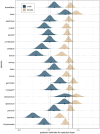A Comparison of Image Statistics of Peacock Jumping Spider Colour Patterns and Natural Scenes
- PMID: 40416758
- PMCID: PMC12101072
- DOI: 10.1002/ece3.71363
A Comparison of Image Statistics of Peacock Jumping Spider Colour Patterns and Natural Scenes
Abstract
The form of arbitrary sexual signals may be driven by the need to be detectable against the background or, alternatively, by selection for efficient processing by the nervous system. This latter alternative is a prediction of the sensory drive hypothesis extended to include efficient coding as a driver of the form of sexual signals. This hypothesis posits that animal visual systems are adapted to process the visual statistics of natural scenes, and that easily processed stimuli induce a sensation of pleasure in the viewer. In support of this, natural scene statistics have been found to be preferred not only by humans, but by the peacock spider Maratus spicatus. Here we test if male peacock spiders of the highly sexually dimorphic Maratus genus generally (a) evolve colour patterns with image statistics that contrast with the natural background or (b) exploit a potential processing bias by evolving colour patterns with visual statistics similar to those of natural scenes. We analyse and compare multispectral images of male and female spiders of 21 Maratus species and of natural scenes similar to the spiders' habitat. We find that the image statistics of male patterns diverge from those of natural scenes, whereas the statistics of female patterns do not. Our results support the idea that colour patterns evolve contrasting image statistics to increase conspicuousness and matching image statistics to be camouflaged. Any processing bias for natural scene image statistics in Maratus thus appears to play little role in the evolution of their sexual signals.
Keywords: Australian peacock spiders; Fourier transform; efficient coding; natural image statistics; processing bias; sexual signalling.
© 2025 The Author(s). Ecology and Evolution published by British Ecological Society and John Wiley & Sons Ltd.
Conflict of interest statement
The authors declare no conflicts of interest.
Figures



References
-
- Andersson, M. B. 1994. Sexual Selection. Princeton University Press.
-
- Balboa, R. M. , and Grzywacz N. M.. 2003. “Power Spectra and Distribution of Contrasts of Natural Images From Different Habitats.” Vision Research 43, no. 24: 2527–2537. - PubMed
-
- Barbosa, A. , Mäthger L. M., Buresch K. C., et al. 2008. “Cuttlefish Camouflage: The Effects of Substrate Contrast and Size in Evoking Uniform, Mottle or Disruptive Body Patterns.” Vision Research 48, no. 10: 1242–1253. - PubMed
-
- Barlow, H. B. 1961. “Possible Principles Underlying the Transformation of Sensory Messages.” Sensory Communication 1: 217–234.
-
- Blest, A. D. , Hardie R. C., McIntyre P., and Williams D. S.. 1981. “The Spectral Sensitivities of Identified Receptors and the Function of Retinal Tiering in the Principal Eyes of a Jumping Spider.” Journal of Comparative Physiology A 145: 127–239.
Associated data
LinkOut - more resources
Full Text Sources

